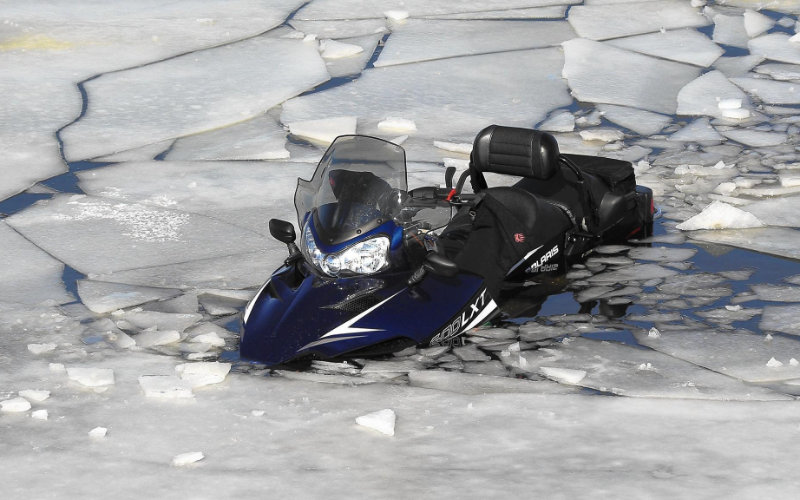Safe Ice Thickness | When Is Ice Safe?

When is ice safe? There is no for-certain absolute answer. Really, ice should never be considered safe. Though there are some safety guidelines to follow for safe ice thickness (listed below).
Safe ice thickness for ice fishing. It’s probably the most common reason for searching for answers in this regard. Whether it’s that, or any other reason, don’t risk your life without knowing the following ice safety guidelines, and the ice thickness chart below.
I’ve sourced data from the Minnesota Department of Natural Resources – I figured that those in MN certainly ought to have good information about this! (“Land of 10,000 Lakes”). This data similarly reflects guidelines from various fishing organizations who publish their recommendations as well.
Ice Thickness Safety
You can’t judge the strength of ice just by its appearance, age, thickness, temperature, or whether or not the ice is covered with snow.
Ice strength is based on ALL these factors — plus the depth of water under the ice, size of the water body, water chemistry and currents, the distribution of the load on the ice, and local climatic conditions.
New Ice vs Old Ice
New ice is usually stronger than old ice. Four inches of clear, newly‑formed ice may be a safe ice thickness to support one person on foot, while a foot or more of old, partially‑thawed ice may not.
Ice Thickness Uniformity
Ice seldom freezes uniformly. It may be a foot thick in one location and only an inch or two just a few feet away.
Ice Over Flowing Water
Ice formed over flowing water and currents is often dangerous. This is especially true near streams, bridges and culverts. Also, the ice on outside river bends is usually weaker due to the undermining effects of the faster current.
Snow Over Ice
The insulating effect of snow slows down the freezing process. The extra weight also reduces how much weight the ice sheet can support.
Ice Near Shore versus Farther Out
Ice near shore can be weaker than ice that is farther out.
Booming Ice
Booming and cracking ice isn’t necessarily dangerous. It only means that the ice is expanding and contracting as the temperature changes.
Fish Movements
Schools of fish in a given location can also adversely affect the relative safety of ice. The movement of fish can bring warm water up from the bottom of the lake. In the past, this has opened holes in the ice causing snowmobiles and cars to break through.
Safe Ice Thickness | Guidelines
For New, Clear Ice Only (and listed caveats)
Double the thickness guidelines when on white ice or “snow ice”, which is only about half as strong as new clear ice.
4″ Okay for Ice Fishing or activities on foot
5″ Ice Thickness for Snowmobile or ATV
8″ – 12″ Thick Ice for Car or small Pickup
12″ – 15″ Ice Thickness for Medium Truck
How To Check Ice Thickness
You might use an ice chisel (a metal rod with a sharp flat blade at one end) to repeatedly stab into the ice to create a hole. Measure with tape measure. Hook the bottom edge of ice before taking measurement.
An auger. Hand, electric, or gas powered. Drill and measure.
Another way is to use a cordless drill with a Long 5/8 inch Wood Auger Bit (wide enough for your tape measure). It won’t take long to drill through the ice to check the depth. Just use a small tape measure to check for safe ice thickness.
White Ice vs Clear Ice
White ice, sometimes called “snow ice,” is only about one-half as strong as new clear ice so the above thicknesses should be doubled.
Ice Thickness Can Vary Widely
Ice is seldom the same thickness over a single body of water. It can be two feet thick in one place and one inch thick a few yards away due to currents, springs, rotting vegetation or school of rough fish.
Vehicle Spacing On Ice
Vehicles weighing about one ton such as cars, pickups or SUVs should be parked at least 50 feet apart and moved every two hours to prevent sinking. It’s not a bad idea to make a hole next to the car. If water starts to overflow the top of the hole, the ice is sinking and it’s time to move the vehicle!
Never Go Out Alone
Use the Buddy System. Have a length of rope. If you go through the ice while you’re alone, well, that’s bad on you.
The Most Popular Ice Cleats
Crampons Ice Cleats
(view on amzn)

Here’s an article that I wrote about my own personal favorite ice cleats:
[ Read: Best Ice Cleats for Shoes & Boots ]
Continue reading: Wind Chill Frostbite Chart
Saving Lake Ice in an Ice House for Ice Box use during Summer
